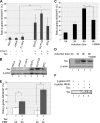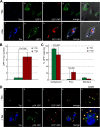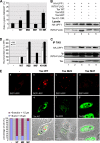The human T-lymphotropic virus type 1 tax protein inhibits nonsense-mediated mRNA decay by interacting with INT6/EIF3E and UPF1
- PMID: 22553336
- PMCID: PMC3416306
- DOI: 10.1128/JVI.07021-11
The human T-lymphotropic virus type 1 tax protein inhibits nonsense-mediated mRNA decay by interacting with INT6/EIF3E and UPF1
Abstract
In this report, we analyzed whether the degradation of mRNAs by the nonsense-mediated mRNA decay (NMD) pathway was affected in human T-lymphotropic virus type 1 (HTLV-1)-infected cells. This pathway was indeed strongly inhibited in C91PL, HUT102, and MT2 cells, and such an effect was also observed by the sole expression of the Tax protein in Jurkat and HeLa cells. In line with this activity, Tax binds INT6/EIF3E (here called INT6), which is a subunit of the translation initiation factor eukaryotic initiation factor 3 (eIF3) required for efficient NMD, as well as the NMD core factor upstream frameshift protein 1 (UPF1). It was also observed that Tax expression alters the morphology of processing bodies (P-bodies), the cytoplasmic structures which concentrate RNA degradation factors. The presence of UPF1 in these subcellular compartments was increased by Tax, whereas that of INT6 was decreased. In line with these effects, the level of the phosphorylated form of UPF1 was increased in the presence of Tax. Analysis of several mutants of the viral protein showed that the interaction with INT6 is necessary for NMD inhibition. The alteration of mRNA stability was observed to affect viral transcripts, such as that coding for the HTLV-1 basic leucine zipper factor (HBZ), and also several cellular mRNAs sensitive to the NMD pathway. Our data indicate that the effect of Tax on viral and cellular gene expression is not restricted to transcriptional control but can also involve posttranscriptional regulation.
Figures









Similar articles
-
Human INT6/eIF3e is required for nonsense-mediated mRNA decay.EMBO Rep. 2007 Jun;8(6):596-602. doi: 10.1038/sj.embor.7400955. Epub 2007 Apr 20. EMBO Rep. 2007. PMID: 17468741 Free PMC article.
-
HTLV-1 Tax plugs and freezes UPF1 helicase leading to nonsense-mediated mRNA decay inhibition.Nat Commun. 2018 Jan 30;9(1):431. doi: 10.1038/s41467-017-02793-6. Nat Commun. 2018. PMID: 29382845 Free PMC article.
-
Characteristic expression of HTLV-1 basic zipper factor (HBZ) transcripts in HTLV-1 provirus-positive cells.Retrovirology. 2008 Apr 22;5:34. doi: 10.1186/1742-4690-5-34. Retrovirology. 2008. PMID: 18426605 Free PMC article.
-
Does the HBZ gene represent a new potential target for the treatment of adult T-cell leukemia?Int Rev Immunol. 2007 Sep-Dec;26(5-6):283-304. doi: 10.1080/08830180701690843. Int Rev Immunol. 2007. PMID: 18027202 Review.
-
HTLV-1 Infection and Adult T-Cell Leukemia/Lymphoma-A Tale of Two Proteins: Tax and HBZ.Viruses. 2016 Jun 16;8(6):161. doi: 10.3390/v8060161. Viruses. 2016. PMID: 27322308 Free PMC article. Review.
Cited by
-
LISTERIN E3 Ubiquitin Ligase and Ribosome-Associated Quality Control (RQC) Mechanism.Mol Neurobiol. 2021 Dec;58(12):6593-6609. doi: 10.1007/s12035-021-02564-x. Epub 2021 Sep 29. Mol Neurobiol. 2021. PMID: 34590243 Review.
-
Nonsense-Mediated mRNA Decay Factor Functions in Human Health and Disease.Biomedicines. 2023 Feb 27;11(3):722. doi: 10.3390/biomedicines11030722. Biomedicines. 2023. PMID: 36979701 Free PMC article. Review.
-
Permissive Sense and Antisense Transcription from the 5' and 3' Long Terminal Repeats of Human T-Cell Leukemia Virus Type 1.J Virol. 2016 Jan 20;90(7):3600-10. doi: 10.1128/JVI.02634-15. J Virol. 2016. PMID: 26792732 Free PMC article.
-
Virus Escape and Manipulation of Cellular Nonsense-Mediated mRNA Decay.Viruses. 2017 Jan 23;9(1):24. doi: 10.3390/v9010024. Viruses. 2017. PMID: 28124995 Free PMC article. Review.
-
The RNA quality control pathway nonsense-mediated mRNA decay targets cellular and viral RNAs to restrict KSHV.Nat Commun. 2020 Jul 3;11(1):3345. doi: 10.1038/s41467-020-17151-2. Nat Commun. 2020. PMID: 32620802 Free PMC article.
References
-
- Abbas S, Erpelinck-Verschueren CA, Goudswaard CS, Lowenberg B, Valk PJ. 2010. Mutant Wilms' tumor 1 (WT1) mRNA with premature termination codons in acute myeloid leukemia (AML) is sensitive to nonsense-mediated RNA decay (NMD). Leukemia 24:660–663 - PubMed
-
- Amor S, et al. 2010. Alternative splicing and nonsense-mediated decay regulate telomerase reverse transcriptase (TERT) expression during virus-induced lymphomagenesis in vivo. BMC Cancer 10:571 doi:10.1186/1471-2407-10-571 - DOI - PMC - PubMed
-
- Anczukow O, et al. 2008. Does the nonsense-mediated mRNA decay mechanism prevent the synthesis of truncated BRCA1, CHK2, and p53 proteins? Hum. Mutat. 29:65–73 - PubMed
-
- Asano K, Phan L, Anderson J, Hinnebusch AG. 1998. Complex formation by all five homologues of mammalian translation initiation factor 3 subunits from yeast Saccharomyces cerevisiae. J. Biol. Chem. 273:18573–18585 - PubMed
Publication types
MeSH terms
Substances
LinkOut - more resources
Full Text Sources
Research Materials
Miscellaneous

